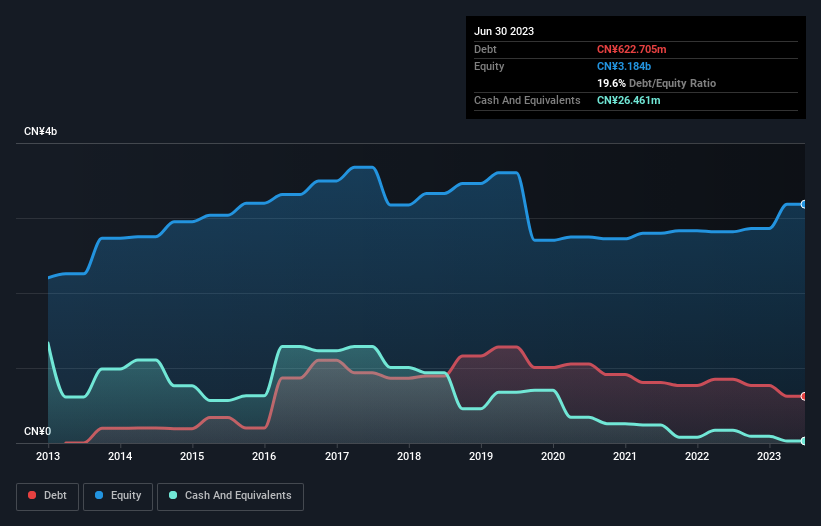
The external fund manager backed by Berkshire Hathaway's Charlie Munger, Li Lu, makes no bones about it when he says 'The biggest investment risk is not the volatility of prices, but whether you will suffer a permanent loss of capital.' It's only natural to consider a company's balance sheet when you examine how risky it is, since debt is often involved when a business collapses. We can see that Tibet Water Resources Ltd. (HKG:1115) does use debt in its business. But the real question is whether this debt is making the company risky.
When Is Debt A Problem?
Generally speaking, debt only becomes a real problem when a company can't easily pay it off, either by raising capital or with its own cash flow. In the worst case scenario, a company can go bankrupt if it cannot pay its creditors. However, a more usual (but still expensive) situation is where a company must dilute shareholders at a cheap share price simply to get debt under control. Having said that, the most common situation is where a company manages its debt reasonably well - and to its own advantage. The first step when considering a company's debt levels is to consider its cash and debt together.
View our latest analysis for Tibet Water Resources
How Much Debt Does Tibet Water Resources Carry?
You can click the graphic below for the historical numbers, but it shows that Tibet Water Resources had CN¥622.7m of debt in June 2023, down from CN¥848.9m, one year before. On the flip side, it has CN¥26.5m in cash leading to net debt of about CN¥596.2m.

How Strong Is Tibet Water Resources' Balance Sheet?
According to the last reported balance sheet, Tibet Water Resources had liabilities of CN¥974.9m due within 12 months, and liabilities of CN¥100.3m due beyond 12 months. Offsetting this, it had CN¥26.5m in cash and CN¥1.31b in receivables that were due within 12 months. So it actually has CN¥259.1m more liquid assets than total liabilities.
This excess liquidity suggests that Tibet Water Resources is taking a careful approach to debt. Because it has plenty of assets, it is unlikely to have trouble with its lenders. The balance sheet is clearly the area to focus on when you are analysing debt. But it is Tibet Water Resources's earnings that will influence how the balance sheet holds up in the future. So when considering debt, it's definitely worth looking at the earnings trend. Click here for an interactive snapshot.
In the last year Tibet Water Resources had a loss before interest and tax, and actually shrunk its revenue by 28%, to CN¥301m. That makes us nervous, to say the least.
Caveat Emptor
While Tibet Water Resources's falling revenue is about as heartwarming as a wet blanket, arguably its earnings before interest and tax (EBIT) loss is even less appealing. Indeed, it lost a very considerable CN¥109m at the EBIT level. Looking on the brighter side, the business has adequate liquid assets, which give it time to grow and develop before its debt becomes a near-term issue. But we'd want to see some positive free cashflow before spending much time on trying to understand the stock. This one is a bit too risky for our liking. The balance sheet is clearly the area to focus on when you are analysing debt. However, not all investment risk resides within the balance sheet - far from it. For example, we've discovered 2 warning signs for Tibet Water Resources (1 is significant!) that you should be aware of before investing here.
If you're interested in investing in businesses that can grow profits without the burden of debt, then check out this free list of growing businesses that have net cash on the balance sheet.
Valuation is complex, but we're here to simplify it.
Discover if Tibet Water Resources might be undervalued or overvalued with our detailed analysis, featuring fair value estimates, potential risks, dividends, insider trades, and its financial condition.
Access Free AnalysisHave feedback on this article? Concerned about the content? Get in touch with us directly. Alternatively, email editorial-team (at) simplywallst.com.
This article by Simply Wall St is general in nature. We provide commentary based on historical data and analyst forecasts only using an unbiased methodology and our articles are not intended to be financial advice. It does not constitute a recommendation to buy or sell any stock, and does not take account of your objectives, or your financial situation. We aim to bring you long-term focused analysis driven by fundamental data. Note that our analysis may not factor in the latest price-sensitive company announcements or qualitative material. Simply Wall St has no position in any stocks mentioned.
About SEHK:1115
Tibet Water Resources
An investment holding company, engages in the manufacture of beverages in the People’s Republic of China.
Adequate balance sheet with weak fundamentals.
Market Insights
Community Narratives


